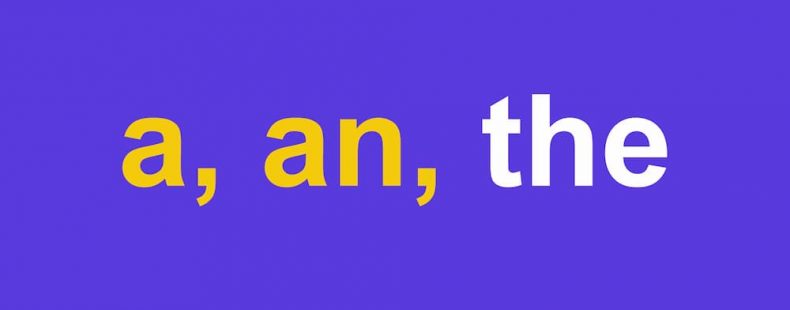Articles are a unique type of adjective that, while short, communicate some important information about a noun.
An article refers to a noun (a person, place, or thing) and specifies its definiteness. This is a formal way of saying that the article lets everyone know whether the noun is specific or unique to the sentence or not.
Not all languages have indefinite and definite articles. English has just one definite article: the, which refers to a specific noun. The indefinite articles a or an refer to nouns more generally.
What is an indefinite article?
Indefinite articles refer to non-specific nouns. You might say, “I need a pen,” or “I want an orange.” In both cases, you aren’t referring to a specific pen or orange. The indefinite articles communicate the fact that you’d accept any pen or orange.
Here are a few more examples:
- Let’s go to a bookstore.
- We need a plumber.
- That’s her drawing of an elephant.
In these examples, it does not matter which bookstore is visited or which plumber is called. (At least check some recommendations, please!) Someone has drawn a picture of an elephant—any elephant, not the specific elephant at the local zoo.
The above examples also demonstrate when to use a versus an. If the word following the article begins with a consonant sound, you should use a. If it begins with a vowel sound, you should use an. So if you added the word large to describe the orange you want, the sentence would become I want a large orange. The same goes for the elephant:
- That’s her drawing of a pink elephant. (They do exist!)
If you’re wondering, an originated before 950 from the Old English word for one, ?n. A is a variant of an.
What is a definite article?
The definite article the, on the other hand, refers to a specific noun. If you were to say, “I want the orange” instead of “an orange,” you’d be talking about one specific orange. If you requested “the pencil” instead of “a pencil,” you’d be asking for one particular pencil.
Here are a few more examples:
- The neighbor’s dog barked at me.
- I lent my brother the book when I finished reading it.
- I don’t want to go to the party.
In all these examples, the article accompanies a specific item that is being discussed. In some cases, the noun has already been named and discussed. For example:
“Did you finish reading The Poet X?”
“Yes, I lent my brother the book when I finished reading it.”
Like a and an, the has roots in Old English and dates before 900.
What if the noun is plural?
A and an only work with singular nouns because they only refer to one item. Plural, non-specific nouns don’t use articles. So if you want more than one orange but don’t care which ones, I want an orange becomes I want oranges.
The works with both singular and plural nouns. If you want a specific orange or specific oranges, you could say, “I want the orange,” or “I want the oranges.”
For example:
- I dropped the blocks and they clattered to the floor.
- I dropped a block.
- We planted trees in the yard.
- We planted a tree in the yard.
What about mass nouns?
Mass nouns are any nouns that can’t be counted. This makes them neither singular nor plural. Liquids are a great example of mass nouns. You’d still use the article the for specific mass nouns, but for non-specific ones, you wouldn’t use an article at all.
For example:
- The water is on the floor.
- Water is on the floor.
Both are are correct. The first refers to specific water, while the second doesn’t.
There’s one exception that allows you to use a or an before a mass noun. This occurs when a specific noun is implied in the context of the sentence. A scenario where this might happen would be at a restaurant. Instead of saying “I’ll have a glass of orange juice,” you’d say, “I’ll have an orange juice.” Orange juice is a mass noun, but in this context it’s implied that you’re referring to a glass of orange juice.
So go ahead and talk about the nouns in your life, in general or specifically. The English language is here to support you!














